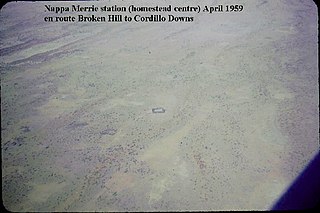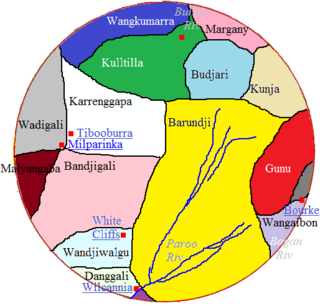
Thargomindah is a rural town and locality in the Shire of Bulloo, Queensland, Australia. The town of Thargomindah is the administrative centre for the Shire of Bulloo. In the 2021 census, the locality of Thargomindah had a population of 243 people.
The Wilson River language, also known as "Modern" Wankumara, is an Australian Aboriginal language of the Karnic family. It was spoken by several peoples along the Wilson River in Queensland. Of these, the Wanggumara (Wangkumara) and Galali may have migrated from the Bulloo River and abandoned their language when they arrived.
The Gidabal, also known as Kitabal and Githabul, are an indigenous Australian tribe of southern Queensland, who inhabited an area in south-east Queensland and north-east New South Wales, now within the Southern Downs, Tenterfield and Kyogle Local Government regions.
Kalali, also written Kullili, Galali, Garlali, Kullilla and other variants, is a poorly attested Australian Aboriginal language, of Queensland, Australia.
Ngura is a disputed and possibly spurious ethnic and language designation of central Australia. The name 'Nura', short for Ngurawarla, means 'empty camp', referring to lands abandoned after a massacre. It is not a language or ethnic designation.

Nappa Merrie Station, most commonly known as Nappa Merrie, is a pastoral lease that operates as a cattle station in central west Queensland, Australia.
The Badjiri people, also written Budjari or Badyidi, are an Australian Aboriginal people of just north of the Paroo River, close to the southern border of Queensland.

The Karenggapa are an Aboriginal Australian people of New South Wales.
The Yawarrawarrka were an in Indigenous people of South Australia.
The Bidjara people, also spelt Bitjara or Bithara, are an Aboriginal Australian people of south-western Queensland. They spoke a dialect of the Ngura language. They are not to be confused with the Warrego River Pitjara or the Badjiri of the Paroo River, both of whose traditional lands are further to the east of the state.
The Dhiraila were an Aboriginal Australian people of the state of Queensland.
The Ngandangara were an indigenous Australian people of the state of Queensland.
The Punthamara were an indigenous Australian people of the state of Queensland.
The Maranganji are an Aboriginal Australian tribe from southwest Queensland.
The Galali or Kalali were an indigenous Australian people of the state of Queensland.
The Wakara or Wakura were an indigenous Australian people of the state of Queensland.
The Maijabi (Mayi-Yapi) were an indigenous Australian people of the state of Queensland.
The Rungarungawa were an Aboriginal Australian people of the state of Queensland.
The Yalarnnga, also known as the Jalanga, are an Indigenous Australian people of the state of Queensland.
The Paaruntyi are an indigenous Australian people of the state of New South Wales. They are not to be confused with the Parrintyi.